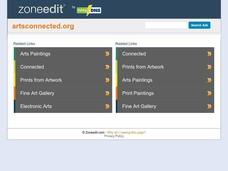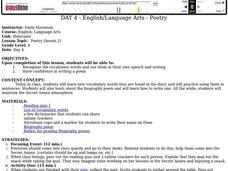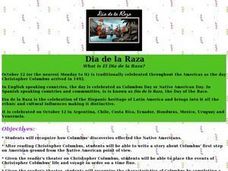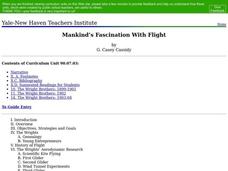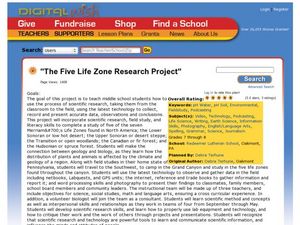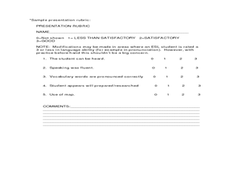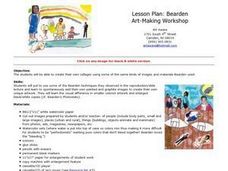English for Everyone
Order of Adjectives
An educational, compact, wonderful worksheet helps learners practice putting adjectives into the proper order. Fourteen multiple choice questions allow them to pick the best order, and then they write two of their own multi-adjective...
Curated OER
Learning About Artists
Students explore various artists and practice creating their style of painting. In this art history lesson, students discover various artists, such as Van Gogh and Michelangelo, and painting style each utilizes. Students paint a picture...
Curated OER
Monoprints With Markers
Students make prints without a printing press. In this printmaking lesson, students make a monoprint by drawing a picture with washable markers, briefly submerging the paper under water, and pressing it onto a new sheet.
Curated OER
Talking Rocks
Third graders consider the differences between pictographs and petroglyphs. They create symbols from a story about their worlds. They make pottery art.
Curated OER
Holocaust
The Holocaust is the focus of this interactive poetry strategy. The classroom will be set-up to remind students of the Secret Annex, with a table, lamp, and various other props. Each participant will receive 3 Saltine crackers and...
Curated OER
Topsy Turvy Kids
Sixth graders study the artwork of Jaune Quick-to-See Smith before creating their own. In this painting lesson, 6th graders examine two pieces of work by Jaune Quick-to-See from the online collection of the Missoula Art Museum and read a...
Curated OER
When a Chair is More than A Chair.....
Students research an artist of their choice and design a piece of art that represents that artist to them. They make sketches, plan their armature, cut out armature, pad with newspapers and apply layers of paper mach??.
Curated OER
Poetry: Using Prosodic Devices
Students examine poetry examples in free verse focusing on their prosodic elements. After critiquing works by several authors, they write their own poems utilizing such devices as alliteration, repetition, rhyme, and stanzas.
Curated OER
Maps and Globes: Where in the World are We?
Students explore maps and globes. In this introduction to map and globe concepts lesson, students identify features of physical maps, political maps, and globes. Students locate land and water, and recite a poem about the names of the...
Curated OER
Dia de la Raza - What is El Dia de la Raza?
Students research and write about Christopher Columbus, his voyages, and his impact on the Native Americans. In this Christopher Columbus instructional activity, students work at stations where they learn vocabulary, perform Reader's...
Curated OER
Discovering National Parks
Students work to preserve American National Parks. In this environmental activism lesson, students research the history of the national parks and determine why they were created. Students then focus on protecting the land, using it for...
Curated OER
Maxim Mix Up
In this language arts worksheet, learners rewrite ten well saying into mixed up sentences. There are 9 mixed up sentences the students must decipher to get their other 9 well known saying. There is an answer key provided.
Curated OER
Commas
Fifth graders discuss when a comma is necessary in a sentence. In this language arts lesson, 5th graders understand that commas are used as a pause and help the reader understand ideas better. Students find an example of each example...
Curated OER
Where in the World...?
Students use longitude and latitude to locate various cities, regions, landforms, and bodies of water around the globe. They use The New York Times Learning Network's crossword puzzle 'Longitude and Latitude' to sharpen their atlas skills.
Curated OER
Mankind's Fascination With Flight
Learners read various novels and articles about the contributions of the Wright Brothers. Individually, they are tested on their comprehension of the material and discuss. In groups, they research the role of the people in their life...
Curated OER
WHAT'S ORGANIC?
Students explore how certain foods come to be certified "organic." They write the words "organic" and "synthetic" and given the definitions of each. Students are given dictionaries. They are asked: "What is organic food?" Students grow...
Curated OER
The Five Life Zone Research Project
Students study five of the seven life zones in North America. In this journalism lesson students use the Scientific Method working in teams. They use lab equipment and technology to create a presentation on five of the seven life zones...
Curated OER
Places in My World
Second graders explore where they are located on the globe. In this maps and globes lesson, 2nd graders use a map to show where they live and show the cardinal directions. Students identify characteristics of mountains, flat land,...
Curated OER
Arthur Meets the President
Students listen to Arthur Meets the President and participate in Internet activities. In this Arthur Meets the President lesson, students become familiar with the work of the President. Students create a KWL about the job of...
Curated OER
Sail Etend 45 Min Cooking Class
In this cooking project worksheet, young scholars work in small groups to make a pizza. Clear directions are given, but some terms are more familiar to children in the U.K. There is a confusing heading on the paper with a date and time...
Curated OER
Bearden Art-Making Workshop
Students are able to create their own collages using some of the same kinds of images and materials Bearden used. They put to use some of the Bearden techniques they observed in the reproduction/slide lecture and explore to...
NWT Literacy Council
Readers Theatre Scripts
Engage and entertain young learners with this collection of readers theatre activities. With over 25 different scripts, a wide range of topics are covered from simple counting and rhyming exercises to adaptions of popular children's...
K5 Learning
A Ship in a Storm
Give reading comprehension a boost with a two-page worksheet featuring an informational text about ships at sea during stormy weather. After reading, scholars show what they know through four short-answer questions.
K12 Reader
What’s Being Compared?
Can your pupils find the comparative or superlative adjectives in each of these sentences? To complete the exercise, individuals circle the adjectives and then note down the things being compared.



